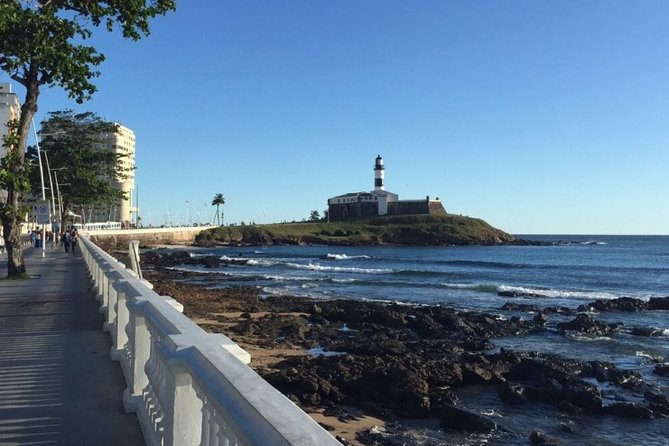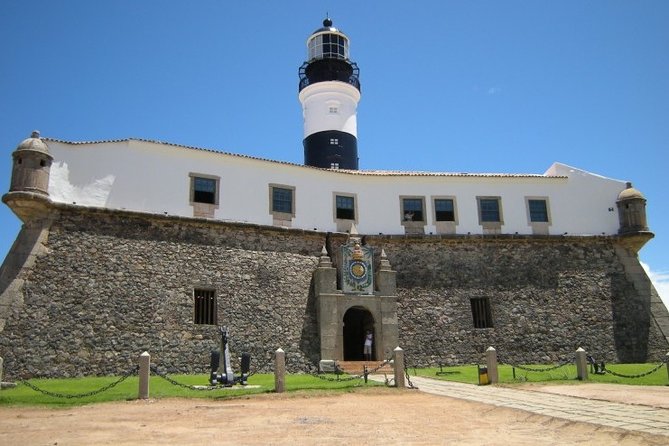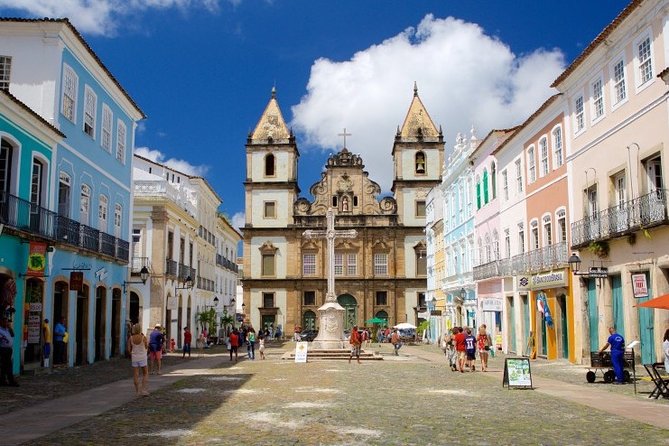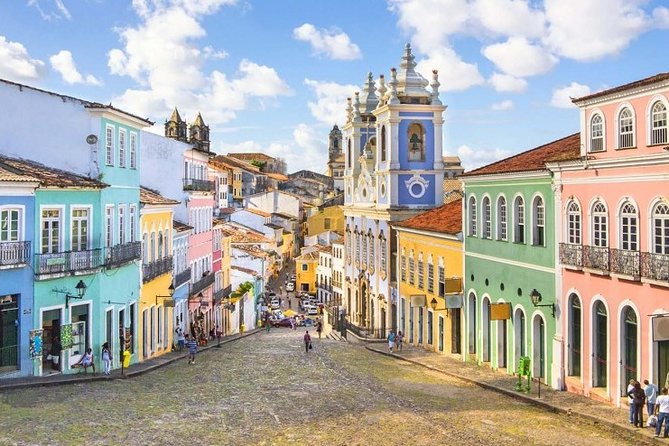Physical Address
304 North Cardinal St.
Dorchester Center, MA 02124
Physical Address
304 North Cardinal St.
Dorchester Center, MA 02124

Bahia’s colonial past comes alive in its vibrant streets and historic architecture. Strolling through the Pelourinho, you can’t help but be captivated by the colorful 17th-century buildings and the rhythm of samba. This UNESCO-protected gem offers a glimpse into Brazil’s rich cultural tapestry, blending African, European, and indigenous influences. But there’s more to uncover in this fascinating region – from the awe-inspiring churches to the mouthwatering Bahian cuisine.

You can also read our reviews of more tours and experiences nearby.

Why is Salvador da Bahia the heart of Brazil’s colonial legacy? This vibrant city on the northeast coast was the first capital of colonial Brazil and a major slave port.
Its colonial architecture, churches, and historic sites transport visitors back in time. Stroll through the winding streets of the Pelourinho neighborhood to see colorful buildings, local shops, and the Igreja de São Francisco with its intricate gold-leafed interior.
Savor Bahian cuisine and samba rhythms, and soak up the unique blend of African, European, and indigenous cultures that define this fascinating destination.

What makes the Pelourinho such a captivating UNESCO World Heritage Site? This historic center of Salvador da Bahia showcases Brazil’s rich colonial past.
Cobblestone streets are lined with colorful, ornate buildings from the 17th and 18th centuries. Visitors can wander through plazas, admire baroque churches, and soak up the vibrant culture.
Cobblestone streets lined with vibrant, ornate 17th and 18th century buildings. Wander plazas, admire baroque churches, immerse in the lively culture.
The neighborhood’s lively markets, music, and cuisine create an immersive experience. Strolling through the Pelourinho, you’ll feel transported to a bygone era.
It’s no wonder this well-preserved district draws visitors from around the world to discover Brazil’s fascinating history and heritage.
Bahia’s churches aren’t just places of worship – they’re architectural marvels that showcase the region’s rich cultural heritage.
The Igreja de São Francisco, for instance, dazzles with its ornate Baroque façade and gilded interior.
Just down the street, the Catedral Basílica is an impressive feat of Neoclassical design, with its towering spires and intricate details.
But the real showstopper is the Igreja do Senhor do Bonfim, renowned for its vibrant, multi-colored tiles that dance across the exterior.
These churches aren’t mere buildings – they’re living, breathing testaments to Bahia’s enduring spirit.
Bahia’s Afro-Brazilian cultural influence is undeniable, woven into every aspect of the region’s vibrant tapestry.
From the rhythmic beats of samba and capoeira to the colorful, lively festivals, Bahia’s African heritage shines.
Visitors can enjoy the Afro-Brazilian traditions at the Pelourinho district, where colonial architecture and bustling markets create a captivating atmosphere.
The aroma of spices and the sound of laughter fill the air, inviting you to experience the rich, centuries-old culture that has shaped Bahia’s identity.
It’s a testament to the resilience and vibrancy of the Afro-Brazilian community.

Delectable aromas waft through the bustling streets of Bahia, beckoning visitors to indulge in the region’s vibrant culinary landscape. From spicy malagueta peppers to the rich, creamy dendê oil, Bahian cuisine is a sensory delight.
Moqueca, a seafood stew simmered in coconut milk, is a local favorite, while acarajé, a fried bean fritter topped with shrimp and spices, is a street food staple. The flavors are bold, the presentation colorful, and the experience unforgettable.
Whether savoring the sweet-and-sour flavors of the tropically inspired tropical soups or the hearty, comforting mains, Bahian cuisine captivates the palate with its unique blend of African, Portuguese, and indigenous influences.
Though Bahia is renowned for its vibrant culinary scene, the region’s literary legacy is equally captivating.
At its heart stands Jorge Amado, one of Brazil’s most celebrated authors. Amado’s vivid novels transport readers to the lively streets of Salvador, capturing the essence of Bahian culture. From the colorful characters to the vivid descriptions, his work has become synonymous with the city.
Visitors can explore the Casa de Jorge Amado, the author’s former home, and trace the influential settings that inspired his legendary tales. Amado’s legacy continues to captivate and inspire, leaving an indelible mark on Bahia’s rich literary heritage.
Beneath the sun-drenched streets of Salvador, Bahia’s cultural heart beats to the rhythm of captivating festivals and time-honored traditions.
Beneath the sun-drenched streets of Salvador, Bahia’s cultural heart beats to the rhythm of captivating festivals and time-honored traditions.
From the vibrant Carnival celebrations that transform the city into a joyous sea of color and music, to the mystical Candomblé rituals that honor the Orixás, Bahia’s cultural tapestry is woven with a rich diversity of customs.
Whether it’s the rhythmic drums of a Capoeira performance or the aroma of sizzling acarajé delicacies, every experience immerses visitors in the unapologetic spirit of this enchanting region.
Bahia’s traditions aren’t just celebrations, but a testament to the resilience and vibrancy of its people.

Tracing the stunning coastline of Bahia, travelers are captivated by the region’s breathtaking beaches that stretch as far as the eye can see.
Sandy paradises like the iconic Praia do Forte and Praia de Itacimirim beckon with their turquoise waters and swaying palm trees.
Further south, the rugged cliffs of the Farol da Barra lighthouse offer panoramic views of the Atlantic.
Whether it’s sunbathing, swimming, or simply soaking in the laid-back Bahian vibes, the beaches of this coastal oasis provide a perfect escape.
With their natural beauty and rich cultural heritage, these shores leave a lasting impression on all who visit.
We've Also reviewed these nearby tours and experiences
The tour excludes the visitation fees for the Church, Farol da Barra, and Casa de Jorge Amado. You’ll need to pay those separately if you want to explore those attractions during your visit.
The tour isn’t wheelchair accessible, but infants can sit on laps. If you need special accommodations, you’ll want to check with the tour operator to see if they can make any arrangements.
The tour allows infants to join, but they’ll have to sit on their parent’s lap. It’s not wheelchair accessible, so those with mobility needs may want to look into other tour options in the area.
This tour has a maximum of 49 travelers. So there’s plenty of room, but not so many that it’ll feel crowded. Just a nice-sized group to explore Bahia’s history and sights together.
Yes, the tour can be canceled up to 24 hours before the experience starts. The tour details state that free cancellation is available up to 24 hours prior to the start of the experience.
Bahia’s vibrant heritage shines through in its captivating architecture, mouthwatering cuisine, and lively festivals. From the cobblestone streets of Pelourinho to the rhythmic beats of samba, this region’s unique identity is the product of diverse cultural influences. Whether strolling along the scenic coastline or immersing oneself in the literary legacy of Jorge Amado, Bahia offers a truly unforgettable experience.